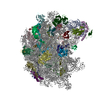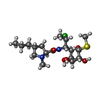+ Open data
Open data
- Basic information
Basic information
| Entry | Database: PDB / ID: 9c4g | ||||||
|---|---|---|---|---|---|---|---|
| Title | Cutibacterium acnes 50S ribosomal subunit with Clindamycin bound | ||||||
 Components Components |
| ||||||
 Keywords Keywords | ANTIBIOTIC / ribosome / clindamycin / acne | ||||||
| Function / homology |  Function and homology information Function and homology informationlarge ribosomal subunit / 5S rRNA binding / large ribosomal subunit rRNA binding / transferase activity / ribosomal large subunit assembly / cytoplasmic translation / cytosolic large ribosomal subunit / tRNA binding / negative regulation of translation / rRNA binding ...large ribosomal subunit / 5S rRNA binding / large ribosomal subunit rRNA binding / transferase activity / ribosomal large subunit assembly / cytoplasmic translation / cytosolic large ribosomal subunit / tRNA binding / negative regulation of translation / rRNA binding / ribosome / structural constituent of ribosome / ribonucleoprotein complex / translation / mRNA binding / metal ion binding / cytoplasm Similarity search - Function | ||||||
| Biological species |  Cutibacterium acnes (bacteria) Cutibacterium acnes (bacteria) | ||||||
| Method | ELECTRON MICROSCOPY / single particle reconstruction / cryo EM / Resolution: 2.53 Å | ||||||
 Authors Authors | Lomakin, I.B. / Devarkar, S.C. / Bunick, C.G. | ||||||
| Funding support |  Canada, 1items Canada, 1items
| ||||||
 Citation Citation |  Journal: J Invest Dermatol / Year: 2024 Journal: J Invest Dermatol / Year: 2024Title: Mechanistic Basis for the Translation Inhibition of Cutibacterium acnes by Clindamycin. Authors: Ivan B Lomakin / Swapnil C Devarkar / Ayman Grada / Christopher G Bunick /  Abstract: Inflammation and the Gram-positive anaerobic bacterium Cutibacterium acnes, which is implicated in acne pathogenesis and pilosebaceous-unit inflammation, are the main targets of antibiotic-based ...Inflammation and the Gram-positive anaerobic bacterium Cutibacterium acnes, which is implicated in acne pathogenesis and pilosebaceous-unit inflammation, are the main targets of antibiotic-based therapy against acne vulgaris (acne). The most widely used antibiotics in acne therapy are tetracyclines, macrolides, and lincosamides. Unfortunately, C. acnes bacteria over the past several decades have demonstrated increased resistance to these antibiotics, particularly to clindamycin. The precise knowledge of how antibiotics interact with their clinical target is needed to overcome this problem. Toward this goal, we determined the structure of clindamycin in complex with the ribosome of C. acnes at 2.53 Å resolution using cryogenic electron microscopy. The galactose sugar moiety of clindamycin interacts with nucleotides of the 23S ribosomal RNA directly or through a conserved network of water-mediated interactions. Its propyl pyrrolidinyl group interacts with the 23S ribosomal RNA through van der Waals forces. Clindamycin binding to the C. acnes ribosome interferes with both: proper orientation of the aminoacyl group of the A-site bound transfer RNA that is needed for peptide bond formation and with the extension of the nascent peptide. Our data are important for advancing the understanding of antibiotic resistance and development of narrow-spectrum antibacterial drugs, which is an urgent need for contemporary antibiotic stewardship. | ||||||
| History |
|
- Structure visualization
Structure visualization
| Structure viewer | Molecule:  Molmil Molmil Jmol/JSmol Jmol/JSmol |
|---|
- Downloads & links
Downloads & links
- Download
Download
| PDBx/mmCIF format |  9c4g.cif.gz 9c4g.cif.gz | 2.3 MB | Display |  PDBx/mmCIF format PDBx/mmCIF format |
|---|---|---|---|---|
| PDB format |  pdb9c4g.ent.gz pdb9c4g.ent.gz | 1.7 MB | Display |  PDB format PDB format |
| PDBx/mmJSON format |  9c4g.json.gz 9c4g.json.gz | Tree view |  PDBx/mmJSON format PDBx/mmJSON format | |
| Others |  Other downloads Other downloads |
-Validation report
| Summary document |  9c4g_validation.pdf.gz 9c4g_validation.pdf.gz | 1.8 MB | Display |  wwPDB validaton report wwPDB validaton report |
|---|---|---|---|---|
| Full document |  9c4g_full_validation.pdf.gz 9c4g_full_validation.pdf.gz | 1.9 MB | Display | |
| Data in XML |  9c4g_validation.xml.gz 9c4g_validation.xml.gz | 138.4 KB | Display | |
| Data in CIF |  9c4g_validation.cif.gz 9c4g_validation.cif.gz | 236.2 KB | Display | |
| Arichive directory |  https://data.pdbj.org/pub/pdb/validation_reports/c4/9c4g https://data.pdbj.org/pub/pdb/validation_reports/c4/9c4g ftp://data.pdbj.org/pub/pdb/validation_reports/c4/9c4g ftp://data.pdbj.org/pub/pdb/validation_reports/c4/9c4g | HTTPS FTP |
-Related structure data
| Related structure data |  45185MC M: map data used to model this data C: citing same article ( |
|---|---|
| Similar structure data | Similarity search - Function & homology  F&H Search F&H Search |
- Links
Links
- Assembly
Assembly
| Deposited unit | 
|
|---|---|
| 1 |
|
- Components
Components
+50S ribosomal protein ... , 25 types, 25 molecules cdefgijklnoprsuvwxyz014V3
-Large ribosomal subunit protein ... , 4 types, 4 molecules mqt2
| #10: Protein | Mass: 20058.641 Da / Num. of mol.: 1 / Source method: isolated from a natural source / Source: (natural)  Cutibacterium acnes (bacteria) / References: UniProt: A0A8B2VJI7 Cutibacterium acnes (bacteria) / References: UniProt: A0A8B2VJI7 |
|---|---|
| #14: Protein | Mass: 11087.788 Da / Num. of mol.: 1 / Source method: isolated from a natural source / Source: (natural)  Cutibacterium acnes (bacteria) / References: UniProt: Q6A9I3 Cutibacterium acnes (bacteria) / References: UniProt: Q6A9I3 |
| #17: Protein | Mass: 13514.626 Da / Num. of mol.: 1 / Source method: isolated from a natural source / Details: loop 49-62 is not modeled, no EM density for it / Source: (natural)  Cutibacterium acnes (bacteria) / References: UniProt: Q6A6N7 Cutibacterium acnes (bacteria) / References: UniProt: Q6A6N7 |
| #26: Protein | Mass: 7457.868 Da / Num. of mol.: 1 / Source method: isolated from a natural source / Source: (natural)  Cutibacterium acnes (bacteria) / References: UniProt: Q6A7V2 Cutibacterium acnes (bacteria) / References: UniProt: Q6A7V2 |
-RNA chain , 2 types, 2 molecules ab
| #28: RNA chain | Mass: 1002554.625 Da / Num. of mol.: 1 / Source method: isolated from a natural source / Source: (natural)  Cutibacterium acnes (bacteria) / References: GenBank: CP012350 Cutibacterium acnes (bacteria) / References: GenBank: CP012350 |
|---|---|
| #29: RNA chain | Mass: 38770.055 Da / Num. of mol.: 1 / Source method: isolated from a natural source / Source: (natural)  Cutibacterium acnes (bacteria) / References: GenBank: 2179609306 Cutibacterium acnes (bacteria) / References: GenBank: 2179609306 |
-Non-polymers , 4 types, 408 molecules 






| #32: Chemical | ChemComp-MG / #33: Chemical | ChemComp-ZN / #34: Chemical | ChemComp-CLY / | #35: Water | ChemComp-HOH / | |
|---|
-Details
| Has ligand of interest | Y |
|---|---|
| Has protein modification | Y |
-Experimental details
-Experiment
| Experiment | Method: ELECTRON MICROSCOPY |
|---|---|
| EM experiment | Aggregation state: PARTICLE / 3D reconstruction method: single particle reconstruction |
- Sample preparation
Sample preparation
| Component | Name: 50S subunit with Clindamycin bound / Type: RIBOSOME / Entity ID: #1-#31 / Source: NATURAL |
|---|---|
| Molecular weight | Experimental value: NO |
| Source (natural) | Organism:  Cutibacterium acnes (bacteria) Cutibacterium acnes (bacteria) |
| Buffer solution | pH: 7.4 |
| Specimen | Embedding applied: NO / Shadowing applied: NO / Staining applied: NO / Vitrification applied: YES |
| Vitrification | Instrument: FEI VITROBOT MARK IV / Cryogen name: ETHANE / Humidity: 100 % |
- Electron microscopy imaging
Electron microscopy imaging
| Microscopy | Model: TFS GLACIOS |
|---|---|
| Electron gun | Electron source:  FIELD EMISSION GUN / Accelerating voltage: 200 kV / Illumination mode: FLOOD BEAM FIELD EMISSION GUN / Accelerating voltage: 200 kV / Illumination mode: FLOOD BEAM |
| Electron lens | Mode: BRIGHT FIELD / Nominal defocus max: 2800 nm / Nominal defocus min: 500 nm / Cs: 2.7 mm / C2 aperture diameter: 50 µm |
| Specimen holder | Cryogen: NITROGEN |
| Image recording | Average exposure time: 1.8 sec. / Electron dose: 38.58 e/Å2 / Film or detector model: GATAN K3 (6k x 4k) |
- Processing
Processing
| EM software | Name: PHENIX / Version: 1.21_5207: / Category: model refinement | ||||||||||||||||||||||||
|---|---|---|---|---|---|---|---|---|---|---|---|---|---|---|---|---|---|---|---|---|---|---|---|---|---|
| CTF correction | Type: PHASE FLIPPING AND AMPLITUDE CORRECTION | ||||||||||||||||||||||||
| Particle selection | Num. of particles selected: 2674133 | ||||||||||||||||||||||||
| 3D reconstruction | Resolution: 2.53 Å / Resolution method: FSC 0.143 CUT-OFF / Num. of particles: 283291 / Symmetry type: POINT | ||||||||||||||||||||||||
| Atomic model building | Protocol: FLEXIBLE FIT / Space: REAL | ||||||||||||||||||||||||
| Refine LS restraints |
|
 Movie
Movie Controller
Controller



 PDBj
PDBj
































